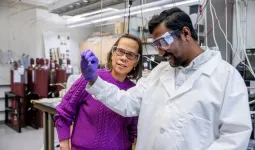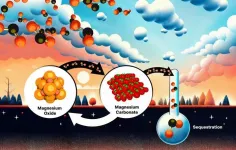(Press-News.org) SAN FRANCISCO—December 8, 2023—It only takes holding your breath for slightly too long to understand that too little oxygen is bad for you. But can you also have too much? Indeed, breathing air with a higher oxygen level than your body needs can cause health problems or even death.
But with scant research on the topic, scientists have known little about how the body senses too much oxygen. Now, a new study from Gladstone Institutes has greatly expanded the scientific body of knowledge about the mechanisms at play, and why it matters for health.
Their findings, reported in the journal Science Advances, explain how breathing air with different levels of oxygen—from too little, to just right, or too much—affects the creation and degradation of different proteins in the lungs, heart, and brain of mice. Notably, the study also highlights a particular protein that may play a central role in regulating how cells respond to hyperoxia.
“These results have implications for many different diseases,” says Gladstone Assistant Investigator Isha Jain, PhD, senior author of the new study. “More than 1 million people in the US breathe supplemental oxygen every day for medical reasons, and studies suggest it could be making things worse in some cases. That’s just one setting where our work is starting to explain what’s happening and how the body responds.”
Understanding Oxygen’s Effects
Most prior research on oxygen levels has examined the molecular effects of too little oxygen. And even in that realm, most of the focus has been on how low oxygen affects which genes are turned on or off.
“Our study enters uncharted territory by using mice and looking downstream of gene expression at which proteins abnormally accumulate or degrade in response to different oxygen concentrations,” says Kirsten Xuewen Chen, first author of the new paper and a graduate student at UC San Francisco.
The research builds on the team’s prior work, which revealed that in response to too much oxygen, certain proteins containing iron and sulfur clusters become degraded, leading cells to malfunction.
“Now, we wanted to get a more dynamic picture of how proteins are regulated when oxygen levels are too high or too low,” Chen says.
To do so, the team exposed mice for several weeks to air with oxygen level of 8 percent, 21 percent (the usual level we breathe in Earth’s atmosphere), or 60 percent. Meanwhile, they gave the mice food containing a distinct form of nitrogen that the animals’ bodies incorporated into new proteins. This nitrogen isotope acted as a “label” that enabled the researchers to calculate protein turnover rates—the balance between protein synthesis and degradation—for thousands of different proteins in the lungs, heart, and brain.
“We’re grateful to our collaborators who are the experts in this technique, known as stable isotope labeling of amino acids in mice,” Jain says. “Without it, we could not have done this study.”
A Key Protein Builds Up
The researchers found that oxygen levels more dramatically affected proteins in the lungs of mice than the heart or brain. They identified certain proteins with abnormal turnover rates under high- or low-oxygen conditions.
One particular protein that accumulated in high-oxygen conditions, MYBBP1A, piqued their attention. MYBBP1A is a transcription regulator, meaning it directly affects gene expression.
“This caught our eye because prior research has shown that other transcription factors called hypoxia-inducible factors, or HIFs, play a big role in cells’ response to low oxygen,” Chen says. “Our work nominates MYBBP1A for a related role in hyperoxia signaling.”
MYBBP1A is involved in the production of ribosomes—cellular “machines” that build proteins. Further experiments surfaced clues that, in response to high oxygen levels, accumulation of this protein in the lungs may affect production of ribosomal RNA, a key component of ribosomes.
Jain’s team is now examining the precise molecular role of MYBBP1A during hyperoxia, including whether its response is protective or harmful. This work could set the stage for novel treatments that target the MYBBP1A protein or associated molecules in ways that counter the bad effects of hyperoxia—similar to widespread research efforts targeting HIF proteins in low-oxygen conditions.
First-of-Its-Kind Dataset
The new study presents a first-of-its kind dataset of protein turnover rates in different tissues of mice exposed to different oxygen levels. The team hopes its results will inspire other researchers to further investigate the effects of too much or too little oxygen on the body, which could transform the way we treat disease.
About the Study
The paper “In Vivo Protein Turnover Rates in Varying Oxygen Tensions Nominate MYBBP1A as a Novel Mediator of the Hyperoxia Response” was published in the journal Science Advances on December 8, 2023.
In addition to Jain and Chen, other authors of the study are: Augustinus Haribowo, Alan Baik, Andrea Fossati, Erica Stevenson, Michela Traglia, Alexander Pico, and Danielle Swaney of Gladstone; Yiwen Chen and Daniel Jarosz of Stanford University; Nabora Reyes, Tien Peng, Michael Matthay, and Abigail Buchwalter of UC San Francisco; and Sina Ghaemmaghami of the University of Rochester
This work was supported by the American Heart Association, the California Institute for Regenerative Medicine, the National Institutes of Health (T32-HL007731, NIH DP5 DP5OD026398), the Chan Zuckerberg Biohub, the Sarnoff Cardiovascular Research Foundation, the UCSF Program for Breakthrough Biomedical Research, the Tobacco-Related Disease Research Program, and a gift from Dave Wentz.
About Gladstone Institutes
Gladstone Institutes is an independent, nonprofit life science research organization that uses visionary science and technology to overcome disease. Established in 1979, it is located in the epicenter of biomedical and technological innovation, in the Mission Bay neighborhood of San Francisco. Gladstone has created a research model that disrupts how science is done, funds big ideas, and attracts the brightest minds.
END
A dynamic picture of how we respond to high or low oxygen levels
A new study from Gladstone Institutes sheds light on the molecular workings at play when oxygen exceeds normal levels, with findings that may one day inform the decision to use supplemental oxygen as a medical treatment.
2023-12-08
ELSE PRESS RELEASES FROM THIS DATE:
University of Toronto researchers discover new lipid nanoparticle that shows muscle-specific mRNA delivery, reduces off-target effects.
2023-12-08
TORONTO – A team of researchers based at the University of Toronto’s (U of T) Leslie Dan Faculty of Pharmacy has discovered a novel ionizable lipid nanoparticle that enables muscle-focused mRNA delivery while minimizing off-target delivery to other tissues. The team also showed that mRNA delivered by the lipid nanoparticles investigated in their study triggered potent cellular-level immune responses as a proof-of-concept melanoma cancer vaccine.
The study, led by Bowen Li, assistant professor, Leslie Dan Faculty of Pharmacy, U ...
Evolving insights in blood-based liquid biopsies for prostate cancer interrogation
2023-12-08
“In the United States, 288,300 new cases of prostate cancer are estimated for 2023 [...]”
BUFFALO, NY- December 8, 2023 – A new research perspective was published in Oncoscience (Volume 10) on November 30, 2023, entitled, “Evolving insights in blood-based liquid biopsies for prostate cancer interrogation.”
During the last decade, blood sampling of cancer patients aimed at analyzing the presence of cells, membrane-bound vesicles, or molecules released by primary tumors or metastatic growths emerged as an alternative to traditional tissue biopsies. The advent of this minimally invasive approach, known as blood-based liquid biopsy, ...
Finding the most heat-resistant substances ever made
2023-12-08
The most durable, heat-resistant materials ever made could be hiding in plain sight.
The U.S. Department of Defense wants to know if minerals and rocks found on Earth and in space hold the secrets of next-generation high-temperature materials. To find out, the DOD awarded $6.25 million through its Multidisciplinary University Research Initiative, or MURI, to a team from the University of Virginia and Arizona State University. The group is led by UVA’s Elizabeth J. Opila, the Rolls-Royce Commonwealth Professor and chair of the Department of Materials Science and Engineering.
The ...
Time-tested magnesium oxide: Unveiling CO2 absorption dynamics
2023-12-08
Magnesium oxide is a promising material for capturing carbon dioxide directly from the atmosphere and injecting it deep underground to limit the effects of climate change. But making the method economical will require discovering the speed at which carbon dioxide is absorbed and how environmental conditions affect the chemical reactions involved.
Scientists at the Department of Energy’s Oak Ridge National Laboratory analyzed a set of magnesium oxide crystal samples exposed to the atmosphere for decades, and another for days to months, to gauge the reaction rates. They found that carbon ...
Engaging heterosexual men more effectively could slash HIV infections in Uganda
2023-12-08
A study looking at 15 years of HIV transmission and suppression in Uganda reveals how closing gender gaps in treatment could slash infection rates.
Providing more heterosexual men with easy access to HIV treatment and care could help to suppress the virus and rapidly cut transmission to their female partners, shows a new study published in Nature Microbiology.
The research, led by scientists from Imperial College London and the Rakai Health Sciences Program in Uganda, analysed 15 years of data from 2003-2018, during which the US President’s Emergency Plan For AIDS ...
A fork in the rhod: Janelia researchers unveil comprehensive collection of rhodamine-based fluorescent dyes
2023-12-08
When Senior Scientist Jonathan Grimm came to Janelia 13 years ago, he didn’t know much about fluorescence or fluorescent dyes. But as an organic chemist who had been working in drug discovery at Merck, he certainly knew a thing or two about medicinal chemistry.
On a whim, Grimm and Janelia Senior Group Leader Luke Lavis decided to try using a mainstay medicinal chemistry reaction Grimm had picked up in the pharmaceutical industry to improve centuries-old dye chemistry. They thought this approach could allow access to completely new, previously inaccessible rhodamines – molecules Lavis had been working to make brighter and longer-lasting so they could be ...
The Gerontological Society of America congratulates new 2023 awardees
2023-12-08
The Gerontological Society of America (GSA) — the country’s largest interdisciplinary organization devoted to the field of aging — is proud to acknowledge the work of 34 outstanding individuals through its prestigious awards program.
GSA salutes outstanding research, recognizes distinguished leadership in teaching and service, and fosters new ideas through a host of awards. Nominated by their peers, the recipients’ achievements serve as milestones in the history and development of ...
Texas A&M Institute part of national effort to harness nuclear laser fusion for limitless energy
2023-12-08
Nuclear fusion, the process that powers the sun, is the ultimate source of energy for all life on Earth. On the sun, deuterium and tritium nuclei combine to produce an alpha particle (the nucleus of a helium atom) and a neutron. The dream is to do the same down here, on Earth, in a controlled manner.
It’s for good reason that harnessing fusion energy is one of the greatest scientific and technological challenges of the 21st century. Fusion requires the fuel to be heated to more than 100 million degrees (10 times hotter than the core of the sun). Practical fusion energy also requires that the burning fuel is kept at these hot temperatures long enough so that energy ...
How health system hesitancies contributed to COVID risks
2023-12-08
More than 1.2 million people have died in the United States during the COVID-19 pandemic to date, more documented deaths than any other nation on Earth.
While many have attributed the high death toll on widespread personal hesitancy to wear masks, avoid crowded places or receive vaccines once they were developed, there were several “system hesitancies” that contributed to the tragic outcomes that need addressing, according to an analysis published Dec. 6, 2023, in Health Affairs Forefront.
The analysis ...
Stand Up to Cancer names Julian Adams, Ph.D., President and CEO
2023-12-08
LOS ANGELES – December 8, 2023 – Stand Up To Cancer® (SU2C) today announced the appointment of Julian Adams, Ph.D., as president and chief executive officer, which will be effective on January 1, 2024. Adams had previously served on SU2C’s Scientific Advisory Committee since 2008, and officially joined SU2C in July 2023 in the newly created position of chief science officer. He succeeds Russell Chew, who joins SU2C’s Board of Directors.
Adams is a longtime oncology researcher and pharmaceutical industry senior executive specializing in drug discovery and development in cancer. With this appointment, Adams assumes management responsibility for SU2C’s overall ...
LAST 30 PRESS RELEASES:
Estimating unemployment rates with social media data
Climate policies can backfire by eroding “green” values, study finds
Too much screen time too soon? A*STAR study links infant screen exposure to brain changes and teen anxiety
Global psychiatry mourns Professor Dan Stein, visionary who transformed mental health science across Africa and beyond
KIST develops eco-friendly palladium recovery technology to safeguard resource security
Statins significantly reduce mortality risk for adults with diabetes, regardless of cardiovascular risk
Brain immune cells may drive more damage in females than males with Alzheimer’s
Evidence-based recommendations empower clinicians to manage epilepsy in pregnancy
Fungus turns bark beetles’ defenses against them
There are new antivirals being tested for herpesviruses. Scientists now know how they work
CDI scientist, colleagues author review of global burden of fungus Candida auris
How does stroke influence speech comprehension?
B cells transiently unlock their plasticity, risking lymphoma development
Advanced AI dodel predicts spoken language outcomes in deaf children after cochlear implants
Multimodal imaging-based cerebral blood flow prediction model development in simulated microgravity
Accelerated streaming subgraph matching framework is faster, more robust, and scalable
Gestational diabetes rose every year in the US since 2016
OHSU researchers find breast cancer drug boosts leukemia treatment
Fear and medical misinformation regarding risk of progression or recurrence among patients with breast cancer
Glucagonlike peptide-1 receptor agonists and asthma risk in adolescents with obesity
Reviving dormant immunity: Millimeter waves reprogram the immunosuppressive microenvironment to potentiate immunotherapy without obvious side effects
Safety decision-making for autonomous vehicles integrating passenger physiological states by fNIRS
Fires could emit more air pollution than previously estimated
A new way to map how cells choose their fate
Numbers in our sights affect how we perceive space
SIMJ announces global collaborative book project in commemoration of its 75th anniversary
Air pollution exposure and birth weight
Obstructive sleep apnea risk and mental health conditions among older adults
How talking slows eye movements behind the wheel
The Ceramic Society of Japan’s Oxoate Ceramics Research Association launches new international book project
[Press-News.org] A dynamic picture of how we respond to high or low oxygen levelsA new study from Gladstone Institutes sheds light on the molecular workings at play when oxygen exceeds normal levels, with findings that may one day inform the decision to use supplemental oxygen as a medical treatment.









